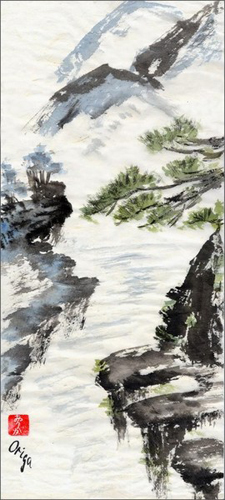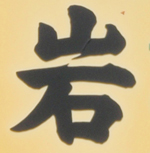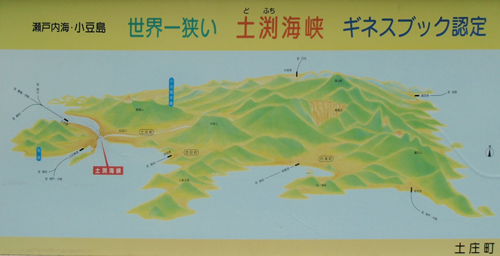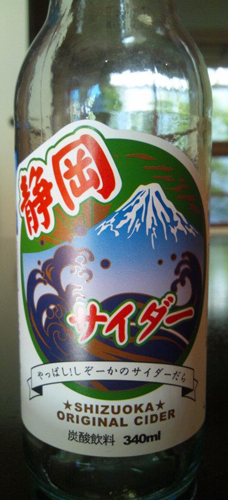46. The "Mountain" Radical: 山
People talk about moving mountains with love or faith, but I remain unconvinced. I'm therefore surprised to see that mountains sometimes levitate in the kanji world! Consider characters such as the following, in which 山, "mountain," is the on-duty radical:
峠 (1663: mountain pass, highest point on a mountain road; peak (of a crisis, trend, etc.)
峰 (1799: peak, mountaintop; ridge)
The 山 has migrated to the left, grown skinny, and risen above the baseline, hovering above nothing. I suppose anything is possible when it comes to kanji!

Image Credit: Origa
"Dream Mountains 2." Painted with sumi ink and Chinese chip colors on rice paper, this work was selected for the 8th Upstream People Gallery International Art Exhibition.
No Variants for the Mountain Kanji
The 山 radical has no variant shapes. A skinny mountain does not qualify as a variant of 山. Nor does the squashed mountain in the next kanji:
島 (358: island)
Incidentally, this kanji combines 鳥 (bird) and "mountain." Henshall presents the etymology as "mountains where birds alight," which is to say "islands in the sea." Lovely! Because the "bird" in 島 steals the spotlight with its size and multitude of strokes, it's easy to overlook the mountain.
By the way, all etymological explanations in this Radical Note come from the earlier edition of Henshall, unless otherwise indicated. Also, 山 is the on-duty radical in every kanji we'll discuss except for one, which I'll bring to your attention.
Names and Positions of the Radical
The 山 radical actually moves about a great deal, and its Japanese names change accordingly. Just as we read the autonomous kanji 山 as やま, we can call the radical やま when this shape is front and center or when it's on the bottom of a kanji:
山 (24: mountain)
岳 (1082: mountain)
When this shape moves to the left, as in 峰, we can call it やまへん.
If it moves on top of some other shape (somehow managing not to crush that other entity), やまかんむり is appropriate:
岩 (249: cliff, rock)
崖 (1977: cliff, precipice)
In English, we call 山 the "mountain" radical, no matter what.

Photo Credit: Eve Kushner
On Sado Island, a sign for a ryokan (inn) includes 岩 (249: cliff, rock).
Mountains Inside Other Land Formations
In all the examples listed above, it's not surprising to find a mountain inside, given their meanings. However, in a host of other characters, it's somewhat startling to locate a 山. Here are two examples of land formations that I don't associate with mountains:
岸 (248: beach)
Here 山 means "high ground." The rest collectively conveys "thrusting cliffs." It seems that we're supposed to focus on the negative space, which is the shore or bank below. That's hard to do when this stacked character draws the eye upward, just as thrusting cliffs would.
峡 (1164: ravine, gorge; strait)
The left side is "mountain." The original form of the right side, 夾, means "to put between," according to the newer edition of Henshall. Combining the parts of 峡, we have “that which comes between mountains”—namely, “ravine,” “gorge,” or “pass.” Again, we're meant to consider the negative space!
I also don't associate capes with mountains. When they consist of steep mountains rising from the sea, it does make perfect sense to affiliate 山 with them, as is the case here:
崎 (1297: cape; small peninsula)
岬 (1840: cape, promontory, headland)
But a cape needn't be high. In that case, the 山 is a bit of a misfit, but I'll give it a pass. Close enough!

Photo Credit: Eve Kushner
This sign features not only a great topographical map of two mountainous islands in the Inland Sea but also two kanji with our "mountain" radical! Do you spot them?! They're in 島 (358: island) and 峡 (1164: ravine, gorge; strait).
Here are the words across the top:
瀬戸内海 (せとないかい: Seto Inland Sea)
小豆島 (しょうどしま: the large island occupying most of the picture)
世界一 (せかいいち: world's number 1)
狭い (せまい: narrow)
土渕 (どふち: name of the strait shown here)
海峡 (かいきょう: strait)
ギネスブック (Guinness Book)
認定 (にんてい: recognition, authorization)
The arrow on the map points to the world's narrowest navigable straits, as recognized by the Guinness Book of World Records. The straits lie between 小豆島 and tiny 前島 (まえじま).
Wind in the Mountains
If it's strange to see mountains in the last set of kanji, what do you make of the next one?
嵐 (1593: storm; mountain air)
This character combines "mountain" with "wind" (風). According to Kanjigen, 嵐 primarily meant “wind or air in the mountains." In Japan 嵐 has evolved to mean “storm” because strong winds (which are connected to storms) often blow in the mountains.
Photo Credit: Eve Kushner
This sign at a store in San Francisco's Japantown tells us that it has merchandise related to the musical group 嵐. That section of the store is called Arashi Corner; the kun-yomi of 嵐 is あらし.
Mountains Turned into Abstractions
It's also a shock to find 山 in three characters that can represent abstractions. Here's how Henshall says that happened:
岐 (1121: diverging)
The part on the left represents "mountain." The right side, which usually means "branch," acts phonetically here to express "fork" and probably also "branching." Originally, 岐 represented a specific mountain in ancient China noted for its twin peaks. This character later evolved to mean "forked mountain" and then just "fork."
崇 (1465: reverence)
The top part is "mountain," and the bottom is "religion," acting phonetically here to lend connotations of "respect" or "awe," among other meanings. Originally, this character referred to a "tall mountain towering over other mountains." People usually use 崇 in the figurative sense of "something lofty and noble that inspires respect and awe," says Henshall.
崩 (1801: crumbling)
The bottom part means "collapsing." In the past, this doubled shape combined with 山 to depict a mountainside that was literally collapsing. Although 崩 still pops up in words for "landslide" and the like, the meaning has broadened, and it can also represent "crumbling" in a more abstract sense.
"Mountain" Is the Radical?
If you can handle it, here's one more surprise. There's a mountain in the kanji below:
岡 (1968: hill; higher place; outside; beside)
This kanji has so much going on that the 山 becomes inconsequential and hard to spot. It's there all the same, and it's the on-duty radical. Kanjigen says that the part that isn't 山 in 岡 means ”rope" and conveys "straight and hard."
Photo Credit:
Ulrike Narins
On part of a sign at a shrine, we see the "mountain" radical twice in a row! The word 東岡崎 (ひがしおかざき) refers to Higashi-Okazaki Station, which is near the shrine. Both are in Okazaki City in Aichi Prefecture, near Nagoya on Honshu.
Just a Component in Other Kanji
In addition to all these characters in which 山 is the on-duty radical, it's a mere component in many other Joyo characters. I find it hard to imagine that a mountain could take a back seat, but that is indeed the case sometimes! You'll see an example of that in the next photo caption.

Photo Credit: Kayoko Kurimoto
A bottle of Shizuoka (静岡, しずおか) Original Cider features our radical in 岡 and in the bottom line: 炭酸飲料 (たんさんいんりょう: carbonated drink). However, 山 is just a component in 炭; the on-duty radical is 火 (radical 86, the "fire" radical). By the way, even though we see サイダー and "Cider" here, this drink contains no apples; サイダー simply means "soda."
